|
|
|
Sort Order |
|
|
|
Items / Page
|
|
|
|
|
|
|
| Srl | Item |
| 1 |
ID:
160032
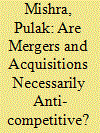

|
|
|
|
|
| Summary/Abstract |
Policy initiatives and regulatory changes made during the last two-and-half decades of economic reforms have led to a considerable increase in the number of mergers and acquisitions (M&As) in the Indian corporate sector. Given the policy-induced flexibilities, while the domestic firms have taken the route of mergers to restructure their business and grow, the foreign firms have preferred to enter into specific markets through acquisitions and raise monopoly power therein. In this context, the present article attempts to examine the impact of M&As on market the structure in major industries of the Indian manufacturing sector during the post-reform period. Using a panel dataset of 34 major industries for the period 2001–2009, the article finds that M&As do not necessarily cause any appreciable adverse impact on market concentration. Instead, the degrees of sellers’ concentration are influenced by the growth of market, capital intensity, firms’ advertising efforts and their financial performance. The findings of the present article, therefore, suggest for a rethink on policies and regulations relating to M&A, international trade and intellectual property, as they play a significant role in enhancing firms’ competitiveness and restricting the emergence of a monopolistic power.
|
|
|
|
|
|
|
|
|
|
|
|
|
|
|
|
| 2 |
ID:
186335
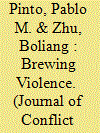

|
|
|
|
|
| Summary/Abstract |
Two prominent features in current world affairs are the unprecedented level of global economic integration and the growing incidence of intrastate violence. We develop and test a novel argument linking global integration through foreign investment to intrastate armed conflict. The presence of multinational corporations in developing countries can cause market concentration, resulting in high rents. Disputes between governments and would-be challengers over the appropriation of these rents are likely to turn violent, increasing the incidence of armed conflict. State capacity mitigates this positive association between foreign investment and intrastate war. Strong states have the capacity to deter rebellions, address citizens’ demands through institutionalized mechanisms, and credibly commit to the peaceful resolution of conflicts. Using data from developing countries for over four decades and addressing potential endogeneity and selection biases, we find strong support for our hypotheses. Our findings have important implications for understanding the link between economic interdependence and conflict.
|
|
|
|
|
|
|
|
|
|
|
|
|
|
|
|
| 3 |
ID:
176123
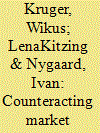

|
|
|
|
|
| Summary/Abstract |
Competitive bidding programmes, or auctions, are becoming the dominant method for procuring utility-scale renewable energy generation capacity and have coincided with significant cost reductions of renewable energy (RE) technologies. The use of price in auctions as the main awarding criterion has been criticized for apparently leading to market concentration and dominance in project ownership. We investigate: to what extent South Africa's renewable energy auction programme has contributed to market concentration and dominance; if market concentration and dominance have a negative impact on electricity cost in the auction; and to what extent measures taken to counteract market concentration and dominance have led to improved competition and diversity of project ownership.
|
|
|
|
|
|
|
|
|
|
|
|
|
|
|
|
| 4 |
ID:
173747
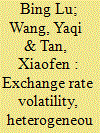

|
|
|
|
|
| Summary/Abstract |
With the gradual promotion of market‐oriented reform of the RMB exchange rate, the fluctuation range of the RMB exchange rate is increasing. How to deal with the impact of exchange rate volatility on Chinese exports is an important challenge faced by China. This paper finds that although exchange rate volatility, as a whole, has a negative impact on exports, high‐productivity exporters are less prone to exchange rate volatility shock in both intensive and extensive margins. As high‐productivity firms are less affected by exchange rate risk, they account for larger market shares. This paper, from a new perspective, provides evidence that increasing productivity helps mitigate the negative impact of exchange volatility on exports.
|
|
|
|
|
|
|
|
|
|
|
|
|
|
|
|
| 5 |
ID:
182547
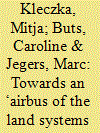

|
|
|
|
|
| Summary/Abstract |
Despite considerable restructuring since the end of the Cold War, the European armoured vehicle industry remains largely fragmented along national lines. As stagnating domestic budgets, rising R&D and production costs and the limits of export-focused industrial strategies provide an economic imperative for further consolidation, the merger of Nexter and Krauss-Maffei Wegmann in 2015 has often been regarded as a mere starting point for a wider trans-European reorganisation process which could even result in a land-based equivalent to Airbus. This article proposes a new classification system to identify the ‘prime competitors’ of the European armoured vehicle industry and debates prospects for further consolidation among them. By means of a volume-based variant of the HHI, concentration in European procurement of armoured vehicles is estimated and various merger simulations are conducted. The results suggest that, while the European armoured vehicle industry will likely experience further consolidation, this process will probably be too small in scope to create an ‘Airbus of the land systems sector’. In the medium to long term, however, market pressures and collaborative programmes such as the Main Ground Combat System might have the potential to create a ‘European champion’ in selected subsectors of the armoured vehicle industry.
|
|
|
|
|
|
|
|
|
|
|
|
|
|
|
|
|
|
|
|
|